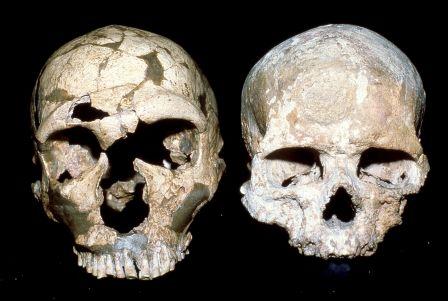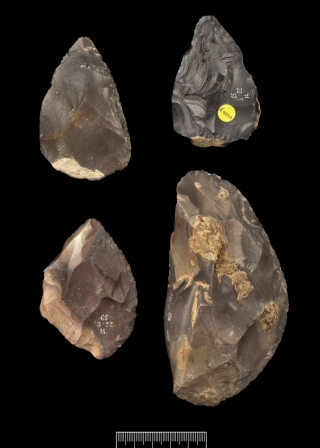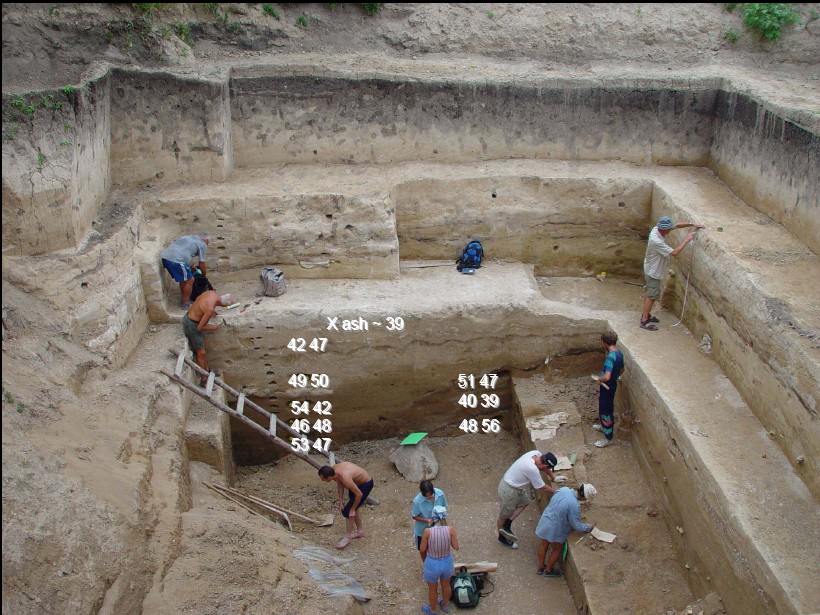WP-1 Neanderthals and modern humans in Europe, 60 to 25 ka BP
 The Neanderthals disappeared about 30 ka BP, but the factors behind their demise are still fiercely debated. While some workers argue that incoming early modern populations genetically absorbed them, other data suggest that they became extinct, with or without some degree of contact. Explanations for their extinction have ranged widely from suggestions of disease or warfare through to economic competition from early modern humans, or the impact of climate change. A scientific answer is now more feasible due to new discoveries and detailed palaeoclimatic records, in particular abrupt environmental transitions (AETs), that allow us to examine in unprecedented detail the period of the Middle-Upper Palaeolithic transition and Neanderthal extinction. But the impact of such research is presently limited by the precision with which we can date and correlate these different archives. The wide application of accelerator radiocarbon dating has provided an approximate framework for study of the period between about 30-40 ka BP, when the last Neanderthals and early modern humans (Cro-Magnons) may have co-existed in western Eurasia. But while accelerator radiocarbon dating gives good precision, it has serious problems of accuracy compared with calendar years during this period, and despite improved techniques and the advent of calibration curves, we still cannot reliably map human populations in relation to each other and the landscape at a finer resolution than several millennia, preventing a convincing answer to many outstanding questions.
The Neanderthals disappeared about 30 ka BP, but the factors behind their demise are still fiercely debated. While some workers argue that incoming early modern populations genetically absorbed them, other data suggest that they became extinct, with or without some degree of contact. Explanations for their extinction have ranged widely from suggestions of disease or warfare through to economic competition from early modern humans, or the impact of climate change. A scientific answer is now more feasible due to new discoveries and detailed palaeoclimatic records, in particular abrupt environmental transitions (AETs), that allow us to examine in unprecedented detail the period of the Middle-Upper Palaeolithic transition and Neanderthal extinction. But the impact of such research is presently limited by the precision with which we can date and correlate these different archives. The wide application of accelerator radiocarbon dating has provided an approximate framework for study of the period between about 30-40 ka BP, when the last Neanderthals and early modern humans (Cro-Magnons) may have co-existed in western Eurasia. But while accelerator radiocarbon dating gives good precision, it has serious problems of accuracy compared with calendar years during this period, and despite improved techniques and the advent of calibration curves, we still cannot reliably map human populations in relation to each other and the landscape at a finer resolution than several millennia, preventing a convincing answer to many outstanding questions.
The key hypothesis to be tested in this work package is whether the archaeological visibility of Neanderthal and Homo sapiens populations is determined by AETs: declining during cold phases and increasing during interstadials. We believe the application of tephrostratigraphy and tephrochronology may provide the means to answer these important questions.
 Aims and Research Objectives
Aims and Research Objectives
The aims of this work package are: (1) to enhance understanding of this crucial extinction event in Europe by mapping different human populations in relation to each other and to AETs; (2) to complement WP-2 by contrasting major cultural and cognitive change that resulted in Europe from population replacement but in North Africa may have occurred within a single anatomically modern human population. Within this work package these will be addressed through a series of research objectives:
- To utilize existing wide-ranging Campanian tephras to refine the accuracy of existing radiocarbon dating
- To map the population histories of the last Neanderthals and first modern humans in Europe through their associated archaeology
- To assess the role of AETs in Neanderthal and early modern human prehistory
Research focus
It is our belief that our current chronological imprecisions are inhibiting further scientific progress in this field and this leaves a number of major unresolved questions:
- Was the arrival of early modern humans essentially a single, or a multiple, process (i.e. were there one or more “Out of Africa” events, perhaps with intermediate Asian residencies)?
- Related to the first question, what route or routes did Homo sapiens use to enter Europe? Routes could have included the Mediterranean coast, Bosphorus/Dardanelles, the Caucasus, or even central Asia.
- Also similarly related, does the appearance of the Aurignacian map a dispersal of early modern humans across Europe and if so what was the source of origin, or was it an indigenous development?
- How much contact was there with the last Neanderthals, and over what timescale? Was there essentially no contact, one pattern of interaction, or diverse interactions across western Eurasia
- What drove the dispersal of modern humans? Could it have been population growth in western Eurasia, perhaps related to cultural or behavioural changes, or climatic ameliorations in Europe? For example, did the first appearance of the Aurignacian coincide with a significant interstadial?
- What behavioural changes occurred in late Neanderthal and early modern populations, and what drove those changes?
- Did the Châtelperronian and comparable "Transitional" industries (made by Neanderthals) overlap chronologically with the Aurignacian? Do such Transitional or non-Aurignacian early Upper Palaeolithic industries reflect acculturation of Neanderthals by contemporaneous Homo sapiens?

The methodology by which this will be achieved includes: (1) the compilation of population histories of prehistoric societies responsible for making Mousterian, Aurignacian and Transitional lithic assemblages from major cave and open air sequences; (2) integration with climatic records from marine, lacustrine, cave and pollen archives; (3) sampling of these archives for micro-tephra volcanic eruptive events to produce a cross-correlated regional event stratigraphy; (4) integration of OSL, TL and U-series age determinations by Bayesian statistical procedures. The result will be a cross-referenced chronology which will allow the alternative models to be evaluated.
Geographical focus
The primary geographical focus of this work package is Europe south of the continental divide, extending from Iberia to the Caucasus and south to the Levant. Other regions of Europe will be included as RESET progresses.
Geographical distribution of the Campanian Ignimbrite eruptive event and its relation to climate & Heinrich events
 The Neanderthals disappeared about 30 ka BP, but the factors behind their demise are still fiercely debated. While some workers argue that incoming early modern populations genetically absorbed them, other data suggest that they became extinct, with or without some degree of contact. Explanations for their extinction have ranged widely from suggestions of disease or warfare through to economic competition from early modern humans, or the impact of climate change. A scientific answer is now more feasible due to new discoveries and detailed palaeoclimatic records, in particular abrupt environmental transitions (AETs), that allow us to examine in unprecedented detail the period of the Middle-Upper Palaeolithic transition and Neanderthal extinction. But the impact of such research is presently limited by the precision with which we can date and correlate these different archives. The wide application of accelerator radiocarbon dating has provided an approximate framework for study of the period between about 30-40 ka BP, when the last Neanderthals and early modern humans (Cro-Magnons) may have co-existed in western Eurasia. But while accelerator radiocarbon dating gives good precision, it has serious problems of accuracy compared with calendar years during this period, and despite improved techniques and the advent of calibration curves, we still cannot reliably map human populations in relation to each other and the landscape at a finer resolution than several millennia, preventing a convincing answer to many outstanding questions.
The Neanderthals disappeared about 30 ka BP, but the factors behind their demise are still fiercely debated. While some workers argue that incoming early modern populations genetically absorbed them, other data suggest that they became extinct, with or without some degree of contact. Explanations for their extinction have ranged widely from suggestions of disease or warfare through to economic competition from early modern humans, or the impact of climate change. A scientific answer is now more feasible due to new discoveries and detailed palaeoclimatic records, in particular abrupt environmental transitions (AETs), that allow us to examine in unprecedented detail the period of the Middle-Upper Palaeolithic transition and Neanderthal extinction. But the impact of such research is presently limited by the precision with which we can date and correlate these different archives. The wide application of accelerator radiocarbon dating has provided an approximate framework for study of the period between about 30-40 ka BP, when the last Neanderthals and early modern humans (Cro-Magnons) may have co-existed in western Eurasia. But while accelerator radiocarbon dating gives good precision, it has serious problems of accuracy compared with calendar years during this period, and despite improved techniques and the advent of calibration curves, we still cannot reliably map human populations in relation to each other and the landscape at a finer resolution than several millennia, preventing a convincing answer to many outstanding questions. Aims and Research Objectives
Aims and Research Objectives
